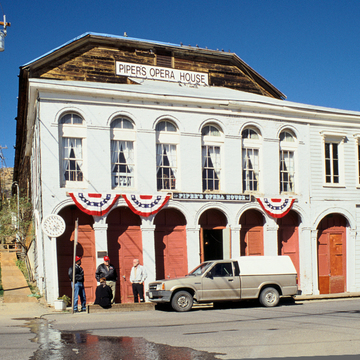Opera houses were mainstays of western mining towns, being the main venues for traveling performers. Though called opera houses, these buildings rarely presented opera. Instead, they accommodated a variety of entertainers, from singers and bands to comedians and lecturers. During the boom days of mining towns many entrepreneurs operated opera houses because
During Virginia City's heyday, John Piper's Opera House attracted famous artists on world tours. The building is notable for the preservation of its 1885 proscenium-arch, or pictureframe, stage, which was developed initially in the seventeenth century to heighten the illusion of the stage set and flourished in the late nineteenth century. The opera house is the third in a series of theaters operated by Piper in Virginia City. The two earlier ones burned down during the Comstock's heyday. After the first was destroyed in the Great Fire of 1875, Piper relocated his business to its present location, using a two-story brick business block built c. 1861 as a facade. After the opera house, located in the back, burned down in 1883, Piper erected a new building in 1885, incorporating once again his two-story brick structure. A blind arcade on the first floor frames doorways into the building and into a saloon formerly in the southeast corner of the lower floor. The front part of the building also provides a transition to the large wooden hall behind it, which contains the theater. Metal pilasters separate the doorways; their lotus capitals are a rare surviving example of 1860s Egyptian Revival architecture, subsequently to be seen in early twentieth-century movie theaters.
Seating on the main floor and in a U-shaped balcony can accommodate 500 people. The auditorium boasts a hand-painted stage curtain and boxes that once seated the bonanza kings, Virginia City's wealthiest and most powerful residents. Pulley systems and nineteenth-century backdrops stand ready at the rear of the stage.
The opera house functioned as a venue for the performing arts as well as a variety of other events. Buffalo Bill, Lillie Langtry, John Philip Sousa and his Peerless Concert Band, and others appeared there. Piper's also presented bear and cat fights, boxing matches, and basketball games. Some of the finest orators of the day, including nineteenth-century freelove advocates and Irish revolutionaries, spoke from its stage. In 1997 a private nonprofit organization purchased the structure and has revived it as a venue for the performing arts. Piper's Opera House is just one example of its type in towns across the American West in the nineteenth century. That Virginia City acquired an opera house in the early years of its existence speaks to the demand for cultural institutions even in sparsely populated, remote frontier towns.














